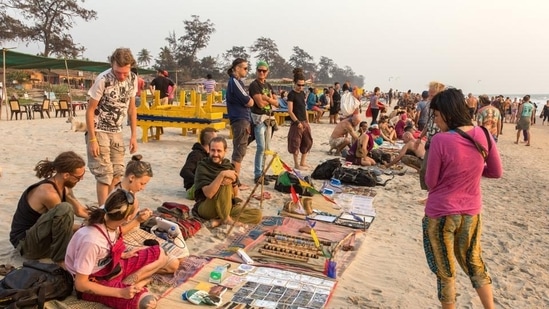
Overtourism: 40 years ago, Goans protested with cow dung and rotten shrimps
8 months ago | 103 Views
December, 1987. Dabolim Airport, Goa.
“Travel Corporation India Pvt Ltd welcomes Condor clients to Goa”.
On a windy December day 37 years ago, a welcome flag was fluttering outside Goa’s Dabolim airport to greet the first group of West German package tourists arriving on a Condor Airlines flight. The Germans were unaware of what lay beyond the exit door - a group of indignant activists of the newly-formed Jagrut Goenkaranchi Fouz (Vigilant Goans' Army) throwing cow dung and rotten shrimps at the bus that was to transport the tourists to various beach resorts. Protesting the onslaught of tourists, local Goans even distributed leaflets in German to convey their stern ‘Tourists Go Home’ message. The fortnight holiday of the Germans began on a stinky, shrimpy note.
But the Germans were not the first ‘mass’ tourists to the idyllic coastal state. Swarms of weed-smoking, dreadlocked hippies had arrived in battered buses on their overland trip (Goa was usually the last stop on the 12,000 kilometre Hippie Trail) and occupied the beaches of Goa in the 1970s. Sepia photographs still live the heady days of full moon rave parties - there’s one photograph of a hippie in bangles, beads and matted locks selling weed labelled ‘Manali Shit’ at Anjuna Beach (there’s a I Love Goa Facebook Page that details Hippies in Anjuna in 1970s).
By the time the hippies left, Goa was already spilling with tourists. In 1985, 775,000 tourists arrived in Goa with foreigners accounting for 12% of the total number. Goa, still a Union Territory, got 7.4% of the total inbound tourist arrival in India. From 1985 up to 2002, there was considerable year-on-year growth with the total arrival touching 1.3 million tourists in 2002 (16.8% being foreigners). The resentment of the local populace towards the swarm of tourists grew increasingly and they were strongly resisting the Government's plan of tourism development and the consequent tourist influx into Goa.
Much before Goa hit the 1-million tourist mark, the world sat up and noticed the burden of ’mass tourism’. A scathing report in The Independent (UK, dated January 27, 1993) headlined: “Mass tourism blamed for paradise lost in Goa: Tour operators who promote an Indian state as a dream holiday destination are accused of turning a blind eye to reality” described how Goa “despite ‘being routinely described in brochures as 'pure joy' (Inspirations India) and an 'unspoilt Paradise' (Hayes and Jarvis), Goa…. is now the scene of acid parties, raves and increasing child prostitution.” The same article cites a Tourism Concern survey that mentions how “one five-star hotel consumes as much water as five villages and one 'five-star tourist' consumes 28 times more electricity per day than a Goan.”
In the mid-1990s, much to the consternation of the local Goans, Union Minister Mufti Mohammed Sayeed prophesied that by the turn of the century, 19 new five-star hotels would come up in the state.
Hotels & Flights:
Sayeed’s prophecy came true. With only two hotels at the time of liberation in 1961, Goa now has 7,538 hotels registered with the Goa Department of Tourism (as of January 31, 2024). According to a rough estimate, there are 6,400 guest houses and hundreds of unregistered accommodation.
Goa is the only state in India that gets the foreign charter tourists. Approximately 341 charter flights landed here in 2022-2023 with tourists from Russia, Kazakhstan, Germany, Israel, Kyrgyzstan (a new market), UK, Europe and the Middle East.
In 1962, Dabolim airport’s runaway was inept at handling even a Boeing 747 but in 2006, 2.2 million passengers used the airport that rose to about 2.6 million in 2007. In 2023, Dabolim airport handled 7 million passengers and 48,195 aircraft movement while the new Manohar International Airport handled 3.7 million passengers and 13,037 flight movements.
Sex, drugs, crime & alcohol:
With the surge in tourism, Goa’s crime graph has also shown an upswing. According to the National Crime Records Bureau (NCRB), in 2022, Goa had the highest rate of minor children being raped in the country as well as a significant surge in economic offence cases in Goa with a sharp increase from 153 First Information Reports (FIRs) in 2020 to 260 in 2022. A concerning trend emerged in crimes committed by foreigners, with the number of cases reaching 67 in 2022, surpassing offences against foreign nationals. Crimes ranged from kidnapping, cheating, rape, forgery, to overstaying and drug-related offence. In 2020, per capita sex tourism in Goa was highest in the country (Source: NCRB). In 2023, the Goa police had seized drugs valued at ₹5.47 crore and the state has also turned into a hub for illegal transportation of alcohol to neighbouring states.
Carrying Capacity:
Goa’s carrying capacity has been under the scanner for years. According to the Goa Tourism Promotion, Management and Regulation Bill 2024, the tourists visiting Goa significantly outnumber the residents and the government is mooting a holistic planning and development of tourism in the State in a manner that is sustainable, ecologically sound, and beneficial to residents and tourists alike. Though tourism is a major contributor to the state exchequer, questions are specially being raised about casino-tourists and busloads of non-spending tourists who cook by the streets, sleep in the coach, crowd the beaches and contribute zilch to the tourism industry.
The big Sunburn Controversy:
The end of the year Sunburn Festival that draws nearly 40,000 tourists has been at the heart of several controversies, including drugs, alcohol and noise pollution. Several public interest litigations (PILs) have been filed against Sunburn for noise pollution in the High Court as well as National Green Tribunal (NGT).
With the organisers planning to move the festival from North to South Goa, the panchayats are up in arms against this EDM saying the festival is associated with ‘drug culture’ and erodes Goa’s cultural values. “South Goa does not need Sunburn EDM. Everyone knows it is associated with drugs & alcohol,” Salesiana Fernandes, Varca sarpanch, told a local newspaper. “The panchayat will oppose tooth & nail any move to hold Sunburn in the village,” Pritam Deulcar, Naquem-Betul sarpanch, added.
Goa’s original Tourism Development Plan:
Three months after Goa’s liberation in December 1961, Libia Lobo Sardesai took over as the state’s first Director of Tourism. Libia (everyone calls her Libby), who turned 100 in May, vividly remembers the Goa of 1962 when there was no ‘mass tourism’, no garbage and tourists did not come for drugs or alcohol. “Most of people who came to Goa were religious tourists (for long, Goa was known as the Rome of the East) or the ones who came to enjoy Goa’s scenic beauty,” said Libby who deeply laments the onslaught of tourists who “do not respect the land or the cultural values and ecological wealth”.
Even in 1962, Libby knew Goa’s potential as a tourist hub and one of her first tasks was to approach United Nations Development Program (UNDP) to facilitate the arrival of foreign journalists to Goa - Press trips to spread the good word globally about Goa’s idyllic landscape.
“Of course, journalists came, they wrote reams about Goa but it all fell apart after my tenure was over in 1968,” added Libby who zealously fought for Goa’s freedom along with her husband Vaman Sardesai who also served as India’s Ambassador to Angola.
Libby’s disquiet is palpable, so is the malaise of mass tourism in Goa that makes her “feel unsafe in my own land”. Goa certainly needs tourists but will the state ever embrace responsible tourism - use tourism to make better places for people to live in and better places for people to visit, in that order?
Read Also: can responsible travel curb overtourism woes?





















